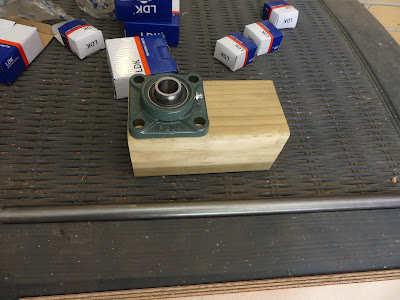Head rotation hinge and test setup
Having worked out that I need to add cheek pressure sensors to detect open reins, and that the motion of the head when asking for the horse to turn the head affects the felt pressure on the reins, I am now turning to allowing the head rotate in a more robust manner. At the same time, I want to make a detached head setup, so that I can easily test the reins interaction from on the ground, without having to mount the "horse".
The first step was to think about what I was going to do for the hinge. So I went out to CBC Bearings at Regency Park and had a chat to the nice folks there, complete with wooden horse head on their counter. They were very helpful, and we settled on using some nice heavy-duty bearings that take a 20mm steel shaft, to make sure that the weight and forces of the heavy horse head moving are easily accommodated without risk of self-damage etc.
The steel shaft I purchased from METALCORP on Grand Junction Road, who were also really helpful. It turns out the woman who served me has horses, so we had a good chat about what I was doing. This is what I ended up with as starting point:
(I did also visit a hydraulics place, but got a rather disinterested and unhelpful customer experience. I think the poor guy drew the short straw for working the Saturday morning of a long weekend when he really wanted to go fishing. But the hydraulics power pack I bought has arrived, so I'll do a post on that soon, too.)
Back to the hinge... It is made of bearings on the top and bottom of the neck mount, and then on the extension of the "spine". These are beefy almost steam-punk looking things:
Once in, they look like this:
A quick fit testing on the piece of neck (which will be attached to the head using a hinge):
Using that, I traced over where the holes needed to go:
For the test setup, I am using a spare piece of marine ply to mount it all on.
Again, mark out where the holes need to go:
And also scribe out the arc of where it needs to be trimmed, to make sure that the head can't collide with it when rotating:
As I don't have a drill press for drilling the long holes through the neck piece, and they needed to be straight to come out the right places on the opposite side of the 90mm square section, I went down to one of our neighbours, Jurg, who was very helpful lending his time, expertise and equipment. Jurg also has a great garden, and often shares his produce, and this was no exception. Yum!
So this is the marine ply after cutting the arc with a jigsaw, and drilling the holes:
And the neck block:
If we were doing it again, we'd take a bit more care, but as a test run, we weren't too worried about exactitude. As a result, only 3 of 4 bolts can go in, until I "move" one of the holes slightly. Here is what it looks like with the bearings attached to the block, and with the 20mm shaft inserted:
Then with it attached to the marine ply:
I was going to use some 2x3 to make legs for the table, but while at the local hardware store to get the bolts, I found they had little furniture legs for $5 each, which would all be the same length, and even have screw-out height trimmers, so I opted for that. With it all assembled:
Next step was to attach the head. The door hinge I had previously used for the vertical motion worked well enough, that I reused that. It's not ideal, but good enough for now. A smaller door hinge would allow all 4 screws to bite into the block, which would be a help.
Now to attach the head to the other side of the hinge:
And stand it up:
I'm glad I made the shaft longer than I thought I would need, as I need almost every bit of its 500mm length to clear the ground, when the head is fully lowered, which it will be for a while, until I build the actuator to pull the head up:
No eating the concrete, Mr. Mechanical Horse!
Anyway, that's that for now. Next step here is to add those cheek sensors, and also a means of measuring the rotation position of the head. I plan to do that super simple and yet super effective by strapping a cheap optical computer mouse to the underside of the neck, so that I can just read the mouse position to get the rotational position. The rate of movement combined with the cheek sensors should indicate the sideways pressure from providing an open rein aid to the "horse". But that will have to wait for the next post.























Comments
Post a Comment